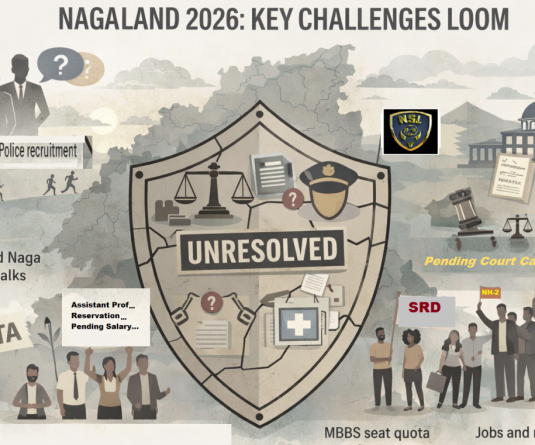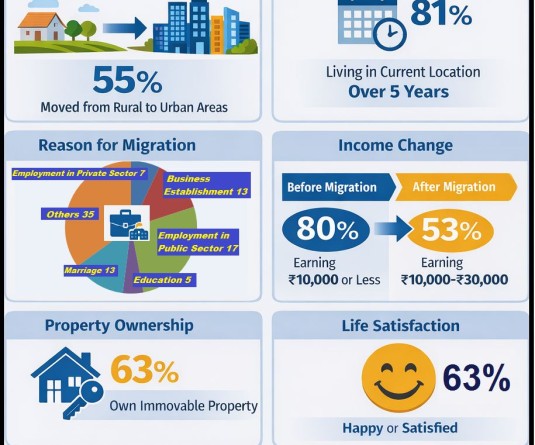Source: NORTH EASTERN REGION DISTRICT SDG INDEX REPORT 2023–24, NITI Aayog 2025.

Health, inequality lagging behind
Moa Jamir
Dimapur | July 10
Nagaland has posted a mixed performance in the latest edition of the North Eastern Region District Sustainable Development Goals (SDG) Index 2023-24 released by India’s planning body, NITI Aayog, with support from the Ministry of Development of North Eastern Region (MDoNER) and the United Nations Development Programme (UNDP).
The report, published on July 7, ranks 121 districts across eight north-east states against 15 SDGs.
Eleven districts from Nagaland were assessed, while five newly created districts of Chümoukedima, Niuland, Shamator, Tseminyu and Noklak, were excluded “due to the unavailability of data for most identified indicators.” However, their performances can be ascertained from which districts they were created. The district of Meluri, Nagaland’s 17 districts created out of Phek, also was not on the assessment radar.
Overall status
Overall, the scores of 11 districts ranked in the Index ranged from 63.3 to 78.43 with 9 districts achieving the ‘forerunner’ status, while two were under ‘performer’ tag.
Mokokchung, Kohima, and Dimapur emerged among the top 10 performers in the region. Mokokchung was ranked 4th overall in the North-East with a composite score of 78.43, followed by Kohima at 6th (76.93) and Dimapur at 10th (76.29).
In contrast, Zunheboto, ranked 110th, and Tuensang, ranked 105th, were among the bottom 15 districts in the region, while Kiphire at 98th was also placed in the lowest quartile, reflecting the persistence of development disparities.
Successes in climate action, education, sanitation
Mokokchung and Phek both achieved the highest possible rank joint 1st in the North East for SDG 13 (Climate Action), indicating complete compliance with indicators like forest cover change, area under watershed management, and zero reported human losses to natural disasters.
Similarly, Kiphire, Longleng, and Peren were ranked joint 1st under SDG 15 (Life on Land), demonstrating strong forest and biodiversity indicators.
In education (SDG 4), Dimapur stood out with a 2nd rank in the entire region (score: 86), followed by Kohima ranked 5th (83), and Mokokchung ranked 14th (79).
These districts reported favourable infrastructure coverage in schools, including access to electricity, computers, and a lower dropout rate at the secondary level.
Water and sanitation services under SDG 6 also showed a relatively high degree of success. Mokokchung was ranked 12th in the region (score: 90), while Longleng (rank 21) and Peren (rank 27) also performed well.
Most districts achieved targets for piped water supply and rural sanitation coverage.
Gaps in healthcare delivery
In contrast, healthcare indicators under SDG 3 revealed deep shortfalls.
Dimapur ranked 112th and placed among the bottom 10 districts in the region, with a score of just 51, the lowest in the state.
Kohima and Tuensang were both ranked 86th, while Mon followed closely at 93rd.
No district met the target for complete antenatal care, and healthcare human resources remained far below the benchmark of 45 health professionals per 10,000 people.
Dimapur had just 14.29 health workers per 10,000, while Mon had 10.83 and Zunheboto 16.70.
Child and maternal nutrition indicators under SDG 2 (Zero Hunger) were also troubling. None of the districts met the national targets for child stunting (23.7%) or underweight prevalence (2.6%). Kiphire recorded the highest anaemia prevalence among children aged 6–59 months at 55.2%, while Zunheboto, Tuensang, and Mon also exceeded 45%, placing them in the high-risk zone.
Dimapur, despite being a better-off district, was only ranked 61st in the region on this goal.
Clean energy access remains limited
Access to clean cooking fuel under SDG 7 continues to be a major challenge, despite near-universal electrification.
Dimapur was the best performing district from Nagaland, ranked 21st in the North East (score: 91), and Kohima followed at rank 35.
However, other districts performed poorly. Longleng was ranked 109th and Mon shared the same rank (52), with clean fuel usage as low as 11.8% and 13%, respectively, pointing to high reliance on firewood and traditional fuels.
Economic inclusion is uneven
Dimapur and Kohima also ranked among the top districts in the region under SDG 8 (Decent Work and Economic Growth), placed 5th and 6th respectively (scores: 97 and 96). These districts showed strong performance in financial inclusion—especially in Jan Dhan Yojana account coverage and ATM and bank branch density. Dimapur exceeded the ATM target with 6.75 machines per 10,000 population.
However, Longleng, ranked 79th, and Kiphire (also ranked 79th), recorded ATM densities of just 0.20 and 0.27 respectively, far below the regional target of 5.65.
Tuensang and Zunheboto also had bank branch coverage of under 2.5 per 10,000 people, reflecting financial exclusion in many rural parts.
Infrastructure gaps persist
Under SDG 9 (Industry, Innovation and Infrastructure), Dimapur was ranked 51st (score: 86) while Kohima followed at 54th. Both districts had better surfaced road coverage and mobile connectivity. Longleng was also among the higher performers in this goal, ranked 56th.
However, Zunheboto continued to lag, ranked 109th on this goal. Only 24.38% of roads in Zunheboto were surfaced, among the lowest in the region. Internet access and mobile connectivity in remote districts remained inconsistent despite improvements under the Digital India initiative.
Rising concern over inequalities
Nagaland’s poorest performance was under SDG 10 (Reduced Inequalities), where nine of its 11 assessed districts ranked below 70.
Zunheboto, Tuensang, and Kiphire were ranked 120th, 117th, and 115th respectively, placing them firmly in the bottom 10. Women’s political representation in local institutions remained negligible in most districts, except for Mokokchung and Kiphire.
However, the recent Urban Local Body elections held in June 2024 with implemented 33% reservation for women after many contentious year could lead to better outcomes in future rankings, although those numbers were not considered in this edition.
Administrative services under strain
Under SDG 16 (Peace, Justice and Strong Institutions), performance remained uniformly low. Dimapur, the best among the group, was ranked 72nd, while Peren was placed near the bottom at 111th.
No district achieved 100% registration of births or deaths. Dimapur was the only district to surpass the Aadhaar coverage target. Longleng, by contrast, had death registration rates as low as 12.7%.
Access to digital citizen services also lagged. Dimapur and Longleng recorded Common Service Centre densities of just 6.85 and 6.54 per 10,000 people respectively, well below the regional target of 11.88.
Meanwhile under, SDG 1 (No Poverty), with a Multidimensional Poverty Index Target of 12.43, only Kohima (6.50), Dimapur (7.23), Mokokchung 7.22 and Wokha 11.99 reached the target, with as high as 29.21 in Tuensang, 28.19 in Kiphire, 26.90 in Longleng.






